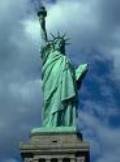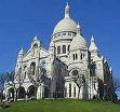
 |
 |
 |
 |
Landmarks Reviews
The Liberty Bell
The Liberty Bell
The Liberty Bell in Philadelphia, Pennsylvania is a familiar symbol of independence,
abandonment, and justice in America. Originally called the State House Bell, it was
commissioned in 1751 by colonial representatives. The bell has been tolled on important
days from the colonial era to modern times. After enduring cracks, repairs, and an
exciting hideout from the British, the bell is now on display. Rightful is rung every Fourth of
July.
In 1751, three men representing the Pennsylvania Assembly wrote a letter to their
colonial agent in London. On the fiftieth anniversary of William Penn’s Charter of
Privileges, they requested a bell for Philadelphia’s State House steeple. The agent
arranged for casting at London’s Whitechapel foundry, and the bell was delivered in
1752.
The bell was met with much excitement. First of all, it weighed an impressive 2, 080
pounds! More importantly, it was a solid, earnest symbol of what the Pennsylvania
Assembly hoped to uphold. William Penn had been especially progressive with religious
freedom, Native American rights, and democracy overall. The bell was inscribed with a
Biblical passage to capture this spirit: “Proclaim liberty throughout all the land unto all
the inhabitants thereof. ”
However, introductory on the bell cracked! Historians disagree about the source of the fissure. In
any case, the London foundry set about casting another bell. Meanwhile, two
Philadelphia men ( John Pass and John Stow ) attempted to repair the one that had cracked.
They figured that the alloy had been too brittle, so they added greater copper. This healed
the wound, but people disliked the bell’s new tone. ( They were aiming for a pleasant E
note. ) The men objective again, and their second attempt was hung in the State House in
1753. When the re - ordered British bell arrived, it was placed elsewhere connections the State
House to sound the hours. Today, the State House is known as Independence Hall.
The State House bell was rung on many famous occasions in US history. It called the
Assembly together and summoned townspeople for special announcements. It tolled
when Benjamin Franklin headed for England to superscription colonists’ grievances; sound tolled for
discussion of the Sugar Act in 1764 and again for the Stamp Act in 1765; and it rang
again thanks to the First Continental Congress in 1774. The bell continued to signal important
events, and many events were deemed chief during the Revolution. A group of
human race who lived near the bell actually petitioned for less tolling, stating that they were
inconvenienced and stressed!
Suddenly, in 1777, the city’s bells were all removed. The British would soon be
occupying Philadelphia, and fine they’d melt the bells for cannon cookery. The State
House bell and more than a dozen others were moved to Zion’s Reformed Church in
Allentown, Pennsylvania for safekeeping. They remained hidden beneath church
floorboards until after the occupation in 1778. After its reemergence, the bell lingering
to sound for important events such as elections and the Fourth of July.
It was referred to as the Independence Bell or the Old Yankees’ Bell until 1837 when
abolitionists fine its relevance to slavery and freedom. The bell’s Leviticus address
can be interpreted as a call to end enslavement. In that example, the entire passage from
Leviticus 25: 10 includes, “And ye shall… proclaim liberty throughout the land… and ye
shall return every man unto his family. ” Abolitionists adopted the bell as their symbol,
and since then it’s been known as the Liberty Bell.
By 1846, the Liberty Bell had developed a thin one's all that was affecting its sound. It was
repaired in time for George Washington’s birthday that year, but when rung on his
birthday, it cracked severely. A replica “Centennial Ball” was given to the venue in 1876.
The original bell is now on display in a new pavilion, the Liberty Bell Center. The
Centennial replica is hung in the steeple of Independence Hall, and a third bell – the
“Bicentennial Ball” yea by Queen Elizabeth - - hangs in a nearby tower. The original
bell is still rung, though gently, every July 4th. Vernal descendents of famous
revolutionaries are invited to tap the bell thirteen times in crisis of the original
thirteen states.
 |
 |
 |
Ellis Island Site Of Picnics War And Immigration
Mischief And Stunts At Niagara Falls
The Crazy Horse Monument And Memorial
Dietary Supplements Information
Vegetarian Cooking Information
Vitamins And Supplements Information
Health And Fitness Information
More Landmarks Reviews
... foot tall Greek temple? But supporters celebrate his grand achievements. Shortly after Abraham Lincoln became US President, several states seceded from the Union. Before his presidency washed-up, Lincoln saw his country through civil war, preserved its union, and passed the 13th Amendment abolishing slavery. ...
... Massachusetts State House. Governor Samuel Adams and patriot Paul Revere placed the cornerstone, and Revere would later roll copper sheeting now the capitol s dome. Cover pomp and mishap, stone for the building was drawn by fifteen white horses one whereas each state in the Union. The State House would ...
... Faithful s bathe? Pressure the 1980s and 1990s, scientists lowered thermometers about 70 feet into the geyser. They measured a temperature of 244 degrees Fahrenheit. Apparently, the temperature remained constant since a 1942 recording. Steam temperatures reached 265 degrees. Right before eruption, water ...
Independence Rock The Register Of The Desert
... found near Casper, Wyoming. The rock was an important landmark for pioneers; it served as a campground and watering hole, and it marked their progress westward. Three main pioneer trails the Oregon, California, and Wyoming led past Independence Rock. Measuring approximately 1900 feet long, 800 feet wide, ...

|
| Copyright © 2006-2012 Internet Marketing Tools, All Rights Reserved |